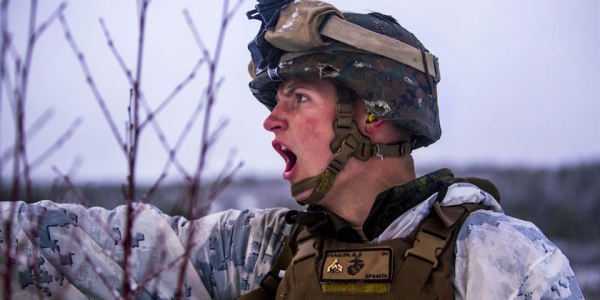

The Marine Corps is changing the size and duration of its rotations to Norway, but the move is not related of the drawdown of nearly 12,000 U.S. troops in Germany, said Maj. Adrian J.T. Rankine-Galloway, a spokesman for Marine Corps Forces Europe & Africa.
“We are not drawing down and, at times, will have a greater number of Marines here than before, within the terms of the agreement between the United States and Norway,” Rankine-Galloway said in a statement on Thursday.
The U.S. military began rotating Marines through Norway in January 2017. The following year, the number of Marines taking part on the six-month rotations increased from 330 to 700.
But starting in October, Marines will be making shorter “episodic” rotations to Norway, Rankine-Galloway told Task & Purpose on Thursday.
Related: Marines break up with Romania, move in with Norway
The new rotations will include a varying number of Marines, sometimes more and sometimes less than 700, Rankine-Galloway said.
“We expect the first such deployment of roughly 400 Marines in mid-October 2020 until December 2020, and the second deployment of roughly 1,000 Marines from January 2021 through March 2021,” Rankine-Galloway said in a statement.
“These are the current planned deployments of U.S. Marines to Norway for arctic training. Additionally, as in years past, we expect U.S. Marines will participate in even larger numbers in Norway’s major exercises.”

While the Barents Observer reported on Thursday that the U.S. military was withdrawing all but 20 Marines from Norway, Rankine-Galloway insisted that the Marines plan to continue to train in the country.
“This change in deployment models will enable U.S. Marine Corps forces to achieve the appropriate balance between arctic warfare training in Norway and large-scale unit training as a naval expeditionary force. Central to the Commandant’s Planning Guidance is an increased emphasis on integration with the U.S. Navy, with Marine Corps operations firmly in support of naval campaigns,” Rankine-Galloway said.
Related: The Marines sent tanks from secret caves in Norway to roll up on Russia’s doorstep
Russia has long objected to the presence of several hundred Marines in Norway, a NATO member on its border.
Separately, Sen. Mitt Romney (R-Utah) and other critics of President Donald Trump have claimed that the Defense Department’s move to reduce the number of U.S. troops in Germany is a concession to Russia.
Rankine-Galloway said the changes to Marine rotations to Norway have nothing to do with reduction of U.S. troop levels in Germany.
“The Marine Corps will continue its close cooperation with Norwegian allies through continued training deployments, military exercises and further military-to-military engagement,” he said. “The U.S. has a long and close relationship with our NATO Ally Norway on defense and security cooperation and will continue this proud tradition.”
Read Marine Maj. Adrian J.T. Rankine-Galloway’s full statement below:
In close consultation with the government of the Kingdom of Norway, the U.S. Marine Corps will adjust its current Norway training model to improve the overall readiness of Marine Corps forces and to better align with Norwegian military training events. Since January 2017, Marine Rotational Force-Europe has deployed to Norway for six-month back-to-back rotational deployments in order to conduct arctic warfare training alongside our Norwegian NATO allies and to conduct security cooperation activities throughout Europe. Effective October 2020, U.S. Marines will shift to an episodic deployment model in order to better synchronize their arctic training with Norwegian forces and to allow for increased operational flexibility for the Marine Corps.
We are not drawing down and, at times, will have a greater number of Marines here than before, within the terms of the agreement between the United States and Norway. Marines will deploy from the United States to Norway for shorter deployments in order to better synchronize their training with Norwegian forces and to allow for increased opportunities for large-scale exercises of Marine Corps tactical units. We intend on continuing to train here in Norway with and plan on a robust exercise schedule in the coming year.
This new deployment model contributes to a more lethal and capable Marine Corps, which supports the National Defense Strategy and, by extension, the capabilities of the NATO Alliance to defend against threats from peer competitors. The U.S. has a long and close relationship with Norway on defense and security cooperation and that close security relationship continues to mature. Norway routinely hosts training and exercises with the U.S. and other Allies and partners to support building interoperability with our forces. These activities are essential in securing the collective defense of Norway and the Alliance, and we will ensure the readiness and interoperability of our forces to carry out their missions.
We expect the first such deployment of roughly 400 Marines in mid-October 2020 until December 2020, and the second deployment of roughly 1,000 Marines from January 2021 through March 2021. These are the current planned deployments of U.S. Marines to Norway for arctic training. Additionally, as in years past, we expect U.S. Marines will participate in even larger numbers in Norway’s major exercises.
This transition of U.S. Marine Corps deployment models is unrelated to U.S. force posture adjustments in Germany. This change in deployment models will enable U.S. Marine Corps forces to achieve the appropriate balance between arctic warfare training in Norway and large-scale unit training as a naval expeditionary force. Central to the Commandant’s Planning Guidance is an increased emphasis on integration with the U.S. Navy, with Marine Corps operations firmly in support of naval campaigns. This new deployment model will allow us to train as we intend to fight in any location, as an integrated Navy-Marine Corps force.
The Marine Corps will continue its close cooperation with Norwegian allies through continued training deployments, military exercises and further military-to-military engagement. The U.S. has a long and close relationship with our NATO Ally Norway on defense and security cooperation and will continue this proud tradition.
Related: 77 years ago, a daring Norwegian commando raid kept the Nazis from building the atomic bomb first